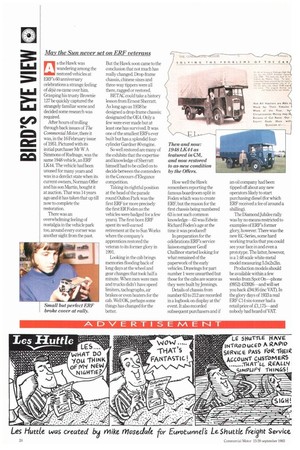May the Sun never set on ERF veterans
Page 26

If you've noticed an error in this article please click here to report it so we can fix it.
A s the Hawk was A s the Hawk was wandering among the restored vehicles at ERF's 60 anniversary celebrations a strange feeling of dejei vu came over him. Grasping his trusty Brownie 127 he quickly captured the strangely familiar scene and decided some research was required.
After hours of trolling through back issues of The Commercial Motor, there it was, in the 16 February issue of 1951. Pictured with its initial purchaser Mr WA Simmons of Radnage, was the same 1948 vehicle, an ERF LK44. The vehicle had been unused for many years and was in a derelict state when its current owners, Norman Offer and his son Martin, bought it at auction. That was 14 years ago and it has taken that up till now to complete the restoration.
There was an overwhelming feeling of nostalgia in the vehicle park too, around every corner was another sight from the past But the Hawk soon came to the conclusion that not much has really changed. Drop-frame chassis, chinese sixes and three-way tippers were all there, ragged or restored.
BETAC could take a history lesson from Ernest Sherratt. As long ago as 1938 he designed a drop-frame chassis; designated the 0E4. Only a few were ever made but at least one has survived. It was one of the smallest ERFs ever built but has a splendid four. cylinder Gardner 80 engine.
So well restored are many of the exhibits that the expertise and knowledge of Sherratt himself had to be called on to decide between the contenders in the Concours d'Elegance competition.
Taking its rightful position at the head of the parade round Oulton Park was the first ERF (or more precisely the first ER Foden as the vehicles were badged for a few years). The first-born ERF spent its well-earned retirement at the to Sun Works where the company's apprentices restored the veteran to its former glory in 1991.
Looking in the cab brings memories flooding back of long days at the wheel and gear changes that took half a minute. When men were men and trucks didn't have speed limiters, tachographs, air brakes or even heaters for the cab. Well OK, perhaps some things has changed for the better. How well the Hawk remembers reporting the famous boardroom split in Foden which was to create ERF, but the reason for the first chassis being numbered 63 is not such common knowledge-63 was Edwin Richard Foden's age at the time it was produced!
In preparation for the celebrations ERF's service liaison engineer Geoff Challinor started looking for what remained of the paperwork of the early vehicles Drawings for part number 1 were unearthed but those for the cabs are scarce as they were built by Jennings.
Details of chassis from number 63 to 212 are recorded in a logbook on display at the' event. It also recorded subsequent purchasers and if an oil company had been tipped off about any new operators likely to start purchasing diesel (for which ERF received a fee of around a The Diamond Jubilee rally was by no means restricted to examples of ERF's former glory, however. There was the new FE-Series, some hard working trucks that you could see your face in and even a prototype. The latter, however, is a 1:48 scale white-metal model measuring 5.5x2x2in.
Production models should be available within a few weeks from Spot On—phone (0952)433926—and will set you back £94.95 (inc VAT). In the glory days of 1933 a real ERF C14 six-tonner had a retail price of L1,175 —and nobody had heard of VAT
















































































